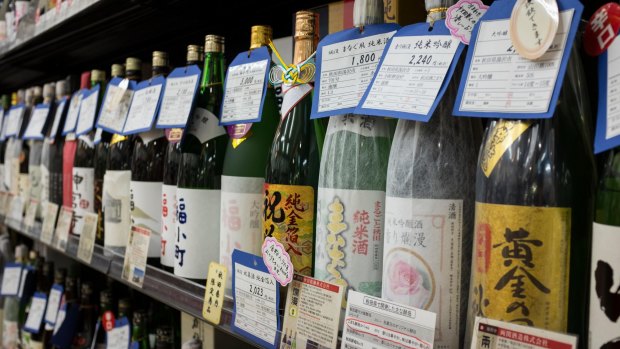This was published 5 years ago
Japan's famous sake breweries, Akita: how only the perfect rice and perfect water make sensational sake

Bottles of sake at Akita Public Market, Akita, Japan. Sake is a Japanese rice wine made by fermenting rice that has been polished to remove the bran.Credit: David Parker / Alamy Stock Photo
In a long room that is cold and dark, rows of steel tanks extend into the gloom. Yet here, in the Taiheizan sake brewery, great things happen – rice and water become sake, the famous Japanese rice wine and a powerful elixir that makes the world seem so good.
I'm about to find out how this popular beverage is created. "This," says the translator Akiko, interpreting the Taiheizan guide's words, "is where the sake is made. It is fermented in these tanks and then bottled and sold."
The guide sweeps his arm around to take in the enormity of the building, to indicate the importance of the process that takes place here. He then turns to me and smiles. And makes to leave.
"Wait," I say to Akiko. "Can you ask how each different sake is made? What is done to make them taste different?"
Akiko translates, listens to the guide's short answer, and then turns back to me with a polite smile. "Different rice. Different water. Different ageing." And then we do leave.
And that's it. That's the answer. I've travelled all the way to Japan's most famous sake-producing prefecture, Akita, and spent time with the country's most passionate creators and consumers of the famed rice wine in a quest to discover all I can about this delicious and difficult-to-understand drink and that's all they're sharing with me: different rice, different water, different ageing.
This, I learn, is somewhat typical of Akita. Sake is a much-loved drink here but the nuances of its creation is not obsessed over by consumers. The specific details of each brewery's recipe also seems to be zealously guarded secrets, like Colonel Sanders' "11 herbs and spices".
Taiheizan is one of the oldest, largest and the most respected of the prefecture's breweries and one of the few that offers public tours of its 100-year-old facility. I'd thought this would help reveal the secrets behind the beverage. I, of course, was wrong. The tour doesn't even include a tasting. I also thought having a translator would lift the curtain, but Akiko doesn't drink, and doesn't seem all that interested in sake's minutiae.
So, I'm on my own. I've got one night in Akita city, a friendly hub on Japan's western coast, to scour its bars for the finest drops, because surely if there's one way to understand sake, it's to drink it.
I'm staying near Kawabata-dori, Akita's nightlife strip, which hosts plenty of bars. However, no one speaks English in these establishments, and Akiko is tucked up in bed, so it's all I can do to sample a few random bottles and try to interpret their flavours. I also discover a well-stocked bottle shop, but again, everything is written in Japanese.
It's not until I've almost given up, as I'm walking back to my hotel to call it a night, that I make a momentous discovery. There, on a street corner just a block from where I'm staying, is Sake-Navi. It's a shop that was built to promote the sake industry in Akita and doubles as a bar and serves sake from every single one of the prefecture's 37 breweries.
It is, in other words, a gift from the sake-drinking gods. Angels are carolling as I stand outside. Light is beaming down from the heavens.
I step in and take a menu, a tasting selection of more than 100 local sakes. I opt for a flight of three, which the staff choose for me. I still don't know which breweries they come from and I don't know the intricacies of their creation. I don't know which rice was used or where the water came from or whether they were aged in steel or concrete or cedar.
I just know they're delicious. And that, I'm finally understanding, is the only secret you need.
TRIP NOTES
FLY
Qantas flies daily from the east coast of Australia to Tokyo, with onward connections to Akita. See qantas.com
STAY
The Alpha-One is a centrally located three-star hotel in Akita with tidy rooms from ¥3900 a night. See alpha-1.co.jp/akita/
TOUR
Tours of the Taiheizan Brewery are from 10am daily, no bookings required. See kodamajozo.co.jp
Sake-Navi is open Monday to Saturday. See sake-navi.akita.jp
MORE
Ben Gorundwater was a guest of the Japan National Tourism Organization.
Sign up for the Traveller Deals newsletter
Get exclusive travel deals delivered straight to your inbox. Sign up now.